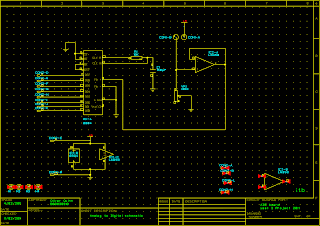From the beginning of February it took 12 Friday afternoon labs to design and build this project, which is basically a computer controlled tactile object recognition system, called a Matrix Sensor. This device communicates with the computer using the parallel port and enables the outline and weight of an object to be displayed on a screen using a Graphic User Interface that was created with the latest version of Microsoft Visual Studio. There are a few parts to the hardware. The Switchboard, which consists of a 4x4 (16) mechanical array of on/off switches, a Force Sensing Resistor (FSR), which provides a force measurement system that, is interfaced to a range of electronic circuits. An ADC single sided board and a multiplexer double sided board.
In the first part of this project, the schematics for the ADC and the Multiplexer boards were handed out on A4 prints. From these they were then created using Cadstar 12 and transferred to PCB artwork design. Once printed onto transfer paper, the designs could then be used to transfer the design onto PCB boards by using UV lights. The boards were then placed in a chemical for Developing and using another chemical for Etching away the copper, leaving the tracks exposed. The next step was to protect the copper tracks by a process called thinning which leaves a protected coat of tin alloy over the tracks. With the two boards finished in the chemical room, the artwork for the switchboard was then handed out on transfer paper to be completed with the same method.
A kit containing the required components for the three boards was handed out and each pad on the boards was dot punched before drilling could begin. Each pad for the components was drilled using a 0.8mm drill bit and a 1mm drill bit was used for the pin connecter pads. The drilling had to be precise to enable connectivity when soldering to the pads. The next part was to begin soldering the components onto the boards and are inter-connected with a 14 pin connector cable that brings the digital signals from the ADC board to the Multiplexer board and an 18 pin connector cable which brings 16 digital signals from the switchboard to the Multiplexer board. (The remaining two pins are for Gnd and power to the switchboard). Once this was completed, a visual check was carried out to examine the solder joints. A Continuity test was then done to check the signals between the IC’s along with its Gnd and power connections and was recorded on an Excel spread sheet. Also recorded were a Power pin test and a Functional test.
The final stage of the project is to interface the hardware with the Software. A basic working version of the software was provided that needed to obtain the correct addresses of the Parallel port on the PC to transfer the signals. The Data port is 8 bits (0-7) and is from pin 2 to pin 9.This reads the values from the ADC. The data port address is 888 Dec and each data line has its own Gnd line to eliminate noise. The Status port has 8 bits (0-7) but are inputs only which reads in data from the MUX and it’s address is 889 Dec. Pin 7 is hardware inverted which means if it reads a logic 1 it is reading 0V, and if it reads a logic 0 then it is 5V. The Control port has another 8 bits (0-7) and allows another 4 pins for use as inputs or outputs. Pins 1, 14 and 17 are hardware inverted. Pin 14 acts as the MUX reset and pin 17 for the clock signal. The address of the Control port is 890 Dec.












